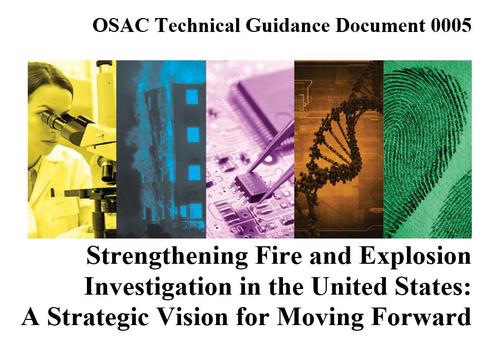Strengthening Fire and Explosion Investigation in the United States: A Strategic Vision for Moving Forward

OSAC Technical Guidance Document 0005
VIEW PDF
Published: April 2021
Author: OSAC Fire & Explosion Investigation Subcommittee (Craig Beyler, Philip Crombie, Chris Connealy, Mark Goodson, John Lentini, Melvin "Dixon" Robin, David Sheppard, Charles "Randy" Watson, Chad Wissinger)
Abstract:
Strengthening Fire and Explosion Investigation in the United States: A Strategic Vision for Moving Forward is a strategic plan for improvements in fire and explosion investigation as a forensic science discipline. The OSAC subcommittee for Fire & Explosion Investigation performed an in-depth examination of the past and current state of fire and explosion investigation and its relationship to the judicial system. The subcommittee then developed a comprehensive series of recommendations for how to improve the practice of fire investigation.
The first edition of NFPA 921 was published in 1992. Much progress has been made since this early recognition of the need to enhance the practice of fire and explosion investigation. The field of fire and explosion investigation can now be said to be in its adolescence, but much work is required to bring it to maturity.
In terms of the impact of NFPA 921 on fire-related litigation, progress has been far more rapid in civil litigation than in criminal matters. Judges and lawyers need to be educated and trained on fire science and investigation to assure that only reliable fire investigations and analyses are presented to juries.
NFPA 1033 has taken its place in defining the qualifications of fire and explosion investigators. The continuing development of NFPA 1033 is needed to support continuing improvements in fire investigation. It has become clear that the current NFPA 1033 educational requirement of a high school degree can no longer be accepted. The 16 knowledge areas which bear on fire and explosion investigation are too sophisticated for investigators to master the needed science and technology working simply from a high school education. Fire is a collection of complex physical and chemical processes that necessitates investigation by those educated in the science and practice of fire and explosion investigation. The day when a BS in one of the physical sciences, engineering, or fire and explosion investigation is the entry-level educational requirement needs to be realized in the coming years.
The field of fire and explosion investigation needs to move toward accreditation of all fire and explosion investigation units. In 2016, the OSAC Fire and Explosion Investigation Subcommittee proposed that NFPA develop a Standard on the Organization and Operation of Fire Investigation Units. That proposal was accepted, a technical committee was formed, and a proposed draft of the standard was submitted to NFPA (NFPA 1321). This standard should provide a foundation for accreditation of fire and explosion investigation units.
Fire and explosion investigation units need to implement information management practices to minimize bias and reduce exposure to task-irrelevant data. Also, there is a need for fire investigation units to fully implement the scientific method and technical review processes to minimize potential bias. All stakeholders need to take responsibility for requiring complete and comprehensive fire and explosion investigation reports.
Sustained funding for fire and explosion investigation research is needed to move the discipline forward. The research agenda detailed in Chapter 7 needs to be implemented. Efforts are required to assure that research for fire investigation is easily accessed by investigators.

